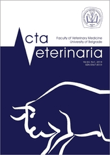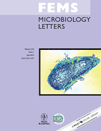
INFECTION GENETICS AND EVOLUTION
Scope & Guideline
Advancing the Frontiers of Infection and Evolution
Introduction
Aims and Scopes
- Genomic Epidemiology:
Research that employs genomic techniques to trace the transmission dynamics and evolutionary patterns of infectious diseases, helping to inform public health responses. - Antimicrobial Resistance:
Studies investigating the genetic basis of antimicrobial resistance in various pathogens, including bacteria and viruses, addressing the global health threat posed by resistant strains. - Phylogenetic Analysis:
Utilization of phylogenetic methods to study the evolutionary relationships among pathogens, aiding in the identification of transmission pathways and potential zoonotic sources. - Pathogen Genomics:
Comprehensive genomic analyses of pathogens to understand their genetic diversity, virulence factors, and host interactions, contributing to vaccine and therapeutic development. - Zoonotic Disease Research:
Explorations of the genetic factors that facilitate the transmission of diseases from animals to humans, focusing on the evolutionary adaptations of pathogens in various hosts. - Vaccine Development and Evaluation:
Research dedicated to the identification of novel vaccine candidates through genomic and immunoinformatic approaches, aiming to enhance vaccine efficacy against infectious diseases. - Microbiome Studies:
Investigations into the role of host-associated microbiomes in influencing infection outcomes and pathogen dynamics, providing insights into host-pathogen interactions.
Trending and Emerging
- Metagenomics and Environmental Pathogen Studies:
There is a growing interest in metagenomic approaches to study environmental and zoonotic pathogens, reflecting the need to understand the complex interactions within ecosystems and their impact on human health. - COVID-19 Research:
Following the global pandemic, there has been a significant uptick in studies related to SARS-CoV-2, focusing on its genetic variants, transmission dynamics, and implications for public health and vaccine development. - Host-Pathogen Interactions:
Emerging research is increasingly focused on the genetic and molecular interactions between hosts and pathogens, providing insights into disease susceptibility and resistance mechanisms. - CRISPR and Genome Editing Technologies:
The application of CRISPR and other genome editing technologies in infectious disease research is on the rise, highlighting innovative strategies for pathogen control and vaccine development. - Antimicrobial Stewardship and Resistance Mechanisms:
There is heightened emphasis on understanding the genetic mechanisms behind antimicrobial resistance, particularly in the context of clinical isolates, to inform stewardship practices and treatment guidelines. - Genomic Surveillance and Public Health:
The trend towards using genomic surveillance as a tool for monitoring infectious diseases and informing public health responses is increasingly prominent, particularly in tracking outbreaks and understanding pathogen evolution.
Declining or Waning
- Traditional Diagnostic Methods:
There is a noticeable reduction in studies focusing on conventional diagnostic techniques, as the field shifts towards molecular and genomic methodologies that offer greater sensitivity and specificity. - Epidemiological Studies without Genetic Component:
Research articles that solely focus on epidemiological data without integrating genetic analysis are becoming less frequent, indicating a shift towards more comprehensive studies that incorporate genetic insights. - Single-Pathogen Focus Studies:
Research that examines individual pathogens in isolation is declining, with a growing preference for studies that consider multi-pathogen interactions and the broader ecological context of infectious diseases. - Basic Virology and Bacteriology:
The journal has seen fewer articles centered on classical virology and bacteriology, as the emphasis has moved towards molecular genetics and evolutionary studies that provide deeper insights into pathogen behavior.
Similar Journals

INTERNATIONAL JOURNAL FOR PARASITOLOGY
Advancing the Frontiers of Parasitology ResearchInternational Journal for Parasitology, published by Elsevier Sci Ltd, stands as a premier platform for disseminating groundbreaking research in the fields of parasitology and infectious diseases. With an impressive impact factor represented by its Q1 quartile rankings in both Infectious Diseases and Parasitology for 2023, this journal commands significant attention within the scientific community. Operating since 1971, it has profoundly contributed to the understanding of parasitic infections and their implications for human health, occupying a distinguished position ranked #7 out of 79 in Parasitology and #64 out of 344 in Infectious Diseases according to Scopus metrics. Although the journal currently does not offer open access options, it ensures rigorous peer review and unparalleled academic integrity, providing researchers, professionals, and students with critical insights necessary for advancing knowledge and fostering innovations in parasitology. Together with its rich historical foundation and commitment to excellence, the journal is indispensable for anyone delving into the complexities of parasites and their impact on both host and ecosystem.

Microbial Genomics
Shaping the Future of Microbial ResearchMicrobial Genomics, an esteemed journal published by the Microbiology Society, is a leading platform dedicated to the rapidly evolving field of microbial genomics. Since its transition to Open Access in 2016, this journal has consistently aimed to promote unprecedented transparency and accessibility in scientific research. Based in the United Kingdom, Microbial Genomics serves a diverse international audience, providing an invaluable resource for researchers, professionals, and students interested in genomics, microbiology, and related fields. With impressive quartile rankings in 2023, including Q1 status in Epidemiology, Genetics, and Microbiology, alongside strong performance in other categories, the journal is positioned at the forefront of academic discourse and innovation. This journal's commitment to excellence is not only reflected in its rigorous peer-review process but also in its dedication to showcasing groundbreaking research that informs current practices and shapes future trends in microbial science. As researchers explore the intricacies of microbial genomes, Microbial Genomics remains an essential resource fostering knowledge and collaboration in the scientific community.

Genome Biology and Evolution
Fostering Collaboration in Evolutionary ScienceGenome Biology and Evolution, published by Oxford University Press, is a leading open-access journal that has been instrumental in advancing research in the fields of genetics and evolutionary biology since its inception in 2009. With an impressive Q1 ranking in both Ecology, Evolution, Behavior and Systematics and Genetics in 2023, the journal is recognized for its high-quality publications that contribute significantly to the understanding of genomic processes across diverse organisms. As part of its commitment to disseminating impactful research, it is dedicated to fostering interdisciplinary collaboration among scientists and providing a platform for innovative findings. Researchers, professionals, and students alike are encouraged to explore the wealth of knowledge within its pages, contributing to ongoing discussions that shape our understanding of evolutionary mechanisms and genomic data interpretation. With its robust access options and a strong commitment to wide dissemination of research, Genome Biology and Evolution remains an essential resource for anyone engaged in the life sciences.

PHYTOPATHOLOGY
Exploring innovative solutions for sustainable agriculture.PHYTOPATHOLOGY, published by the American Phytopathological Society, is a premier journal dedicated to advancing the science of plant pathology. With an ISSN of 0031-949X and E-ISSN 1943-7684, this journal has been a cornerstone of scholarly communication in the field since its inception in 1946. Ranked in the top quartile (Q1) in both Agronomy and Crop Science and Plant Science for 2023, PHYTOPATHOLOGY has garnered notable recognition with Scopus ranks placing it at #86/516 (83rd percentile) in Plant Science and #69/406 (83rd percentile) in Agronomy and Crop Science. The journal publishes high-quality research articles, reviews, and case studies that explore innovative solutions to plant diseases, thereby supporting agricultural productivity and sustainability. While currently not an open-access journal, it offers vital insights and findings that are invaluable to researchers, professionals, and students aiming to advance their knowledge and contribute to the field of plant sciences.

DEVELOPMENT GENES AND EVOLUTION
Advancing Knowledge in Developmental Biology and Genetics.DEVELOPMENT GENES AND EVOLUTION is a prominent academic journal published by Springer, dedicated to advancing the fields of developmental biology and genetics. With an ISSN of 0949-944X and an E-ISSN of 1432-041X, this journal plays a crucial role in disseminating high-quality research that explores the genetic underpinnings of developmental processes across various organisms. Located in the United States, the journal has maintained a strong international presence with a significant impact factor, reflecting its importance in the scientific community. It currently holds a Q3 ranking in both developmental biology and genetics, according to the latest 2023 category quartiles, indicating a solid standing among peers. With a convergence of insights from 1996 to 2024, the journal publishes original articles, reviews, and research notes that attract a diverse readership of researchers, professionals, and students. Access options include traditional subscription models and open access, ensuring that vital research is available to a broad audience. By fostering discussions on the evolution of developmental mechanisms, DEVELOPMENT GENES AND EVOLUTION continues to be an essential resource for those interested in understanding the intricate interplay between genetics and development.

COMPARATIVE IMMUNOLOGY MICROBIOLOGY AND INFECTIOUS DISEASES
Innovating Research in Infectious Disease ScienceComparative Immunology Microbiology and Infectious Diseases, published by Elsevier Science Ltd, is a prominent journal dedicated to advancing the fields of immunology, microbiology, infectious diseases, and veterinary sciences. Established in 1978, this journal has become a vital resource for researchers and professionals alike, with a commendable impact factor that reflects its significance in academia. The journal, available in both print and electronic formats (ISSN: 0147-9571, E-ISSN: 1878-1667), stands out for its commitment to disseminating innovative research findings, particularly through its categorization in Q2 and Q3 quartiles across various related disciplines as of 2023. The journal aims to provide insightful comparative analyses that enhance our understanding of host-pathogen interactions, immune responses, and disease manifestations. With a global readership base, it serves as a platform for collaborative discourse among scientists and professionals, ultimately contributing to the improvement of health outcomes worldwide.

ACTA VETERINARIA-BEOGRAD
Transforming veterinary practices with cutting-edge discoveries.ACTA VETERINARIA-BEOGRAD is a distinguished academic journal dedicated to the field of veterinary science, focusing on a broad spectrum of topics pertinent to veterinary medicine and animal health. Published by SCIENDO, this journal has been an open-access resource since 2014, facilitating the dissemination of valuable research findings and innovations to a global audience. With an ISSN of 0567-8315 and an E-ISSN of 1820-7448, it plays a critical role in promoting accessible knowledge in veterinary practices while contributing to the advancement of the field. Located in Poland, this journal notably ranks in the Q3 quartile for veterinary studies, reflecting its ongoing commitment to quality and relevance. The journal welcomes contributions from a diverse range of veterinary disciplines, making it a vital platform for researchers, practitioners, and students alike who aspire to advance their understanding and impact within the veterinary community.

FEMS MICROBIOLOGY LETTERS
Fostering Dialogue in the Realm of MicrobiologyFEMS Microbiology Letters, published by Oxford University Press, is a prestigious international journal dedicated to advancing the understanding of microbiology through concise and impactful research articles. With an ISSN of 0378-1097 and E-ISSN 1574-6968, this journal encompasses a wide range of topics within the fields of genetics, microbiology, and molecular biology, achieving a notable Q3 quartile ranking in these categories as of 2023. As an essential platform for researchers, professionals, and students, FEMS Microbiology Letters invites submissions that contribute valuable insights into microbial behaviors, genetic mechanisms, and innovative methodologies pivotal in the study of microbiology. Although it is not an open-access publication, the journal's rigorous editorial standards ensure high-quality content that is relevant and significant to its audience, furthering scholarly dialogue and collaboration in the vibrant field of microbiological research.

Evolutionary Bioinformatics
Transforming evolutionary studies with cutting-edge techniques.Evolutionary Bioinformatics, published by SAGE Publications Ltd, is a pioneering open-access journal established in 2005, dedicated to advancing the field of evolutionary biology through innovative computational techniques and bioinformatics. With an ISSN of 1176-9343, it serves as a critical platform for researchers, professionals, and students to disseminate impactful findings and foster collaboration across disciplines. The journal spans a broad scope, contributing significantly to the areas of Ecology, Evolution, Behavior and Systematics, and Genetics, as evidenced by its respectable Scopus rankings and quartile placements in 2023. With a commitment to providing comprehensive, peer-reviewed research articles and tools for sharing knowledge, Evolutionary Bioinformatics plays an essential role in shaping the future of evolutionary studies and bioinformatics. Readers and contributors alike are encouraged to engage with cutting-edge research that pushes the boundaries of understanding in this dynamic field.

MICROBES AND INFECTION
Transforming Knowledge into Clinical PracticeMICROBES AND INFECTION is a premier academic journal published by Elsevier, dedicated to the dynamic fields of immunology, infectious diseases, and microbiology. With a notable impact factor reflective of its high-quality research contributions, the journal is categorized in the Q2 quartile across these fields as of 2023. Based in France and operating since 1999, MICROBES AND INFECTION offers a platform for researchers, professionals, and students to disseminate and access cutting-edge findings that drive innovation and knowledge in microbial and infectious disease research. The journal is ranked impressively within the Scopus database, securing ranks such as #16 in Microbiology and #33 in Infectious Diseases, underscoring its high relevance in the scientific community. Subscribers to the journal can expect an array of articles, reviews, and original research, all designed to advance understanding and improve clinical practices in the fight against infectious agents. With its ongoing commitment to open access options, MICROBES AND INFECTION continues to foster global collaboration and information sharing in the pursuit of addressing pressing microbiological challenges.